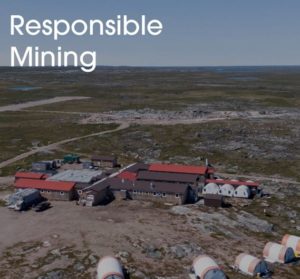In recent years, a more environmental consciousness has permeated the Canadian mining industry. This is most aptly demonstrated by Canadian North Resources (CNR). With a large critical mineral project located at Kivalliq Region in the mining quarter of Nunavut, CNR is a late-stage exploration & development mining entity that focuses on base metals, including copper, nickel, and cobalt, as well as platinum group metals, including palladium and platinum. We spoke to CNR about how such practices are advantageous both economically and environmentally to the surrounding mining landscape in Canada.
When speaking to CNR, we found that their green footprint is of utmost importance. The exploration of base metals and PGM are evolving in the clean energy, electric vehicles, and high-tech industries across the world. This places CNR in the prime position as an active participant in Canada’s transition to a low-carbon economy.
CNR’s CEO, Dr. Kaihui Yang, highlighted the significance of Canada’s green economy. Yang explained that: “Green economy needs green metals such as copper, nickel, cobalt, palladium and platinum. Considering the geopolitical climate in many of the countries, governments are looking to source the green metals from countries such as Canada, which have a stable political system and strong environmental standards for mining.” This creates a symbiotic relationship between CNR and the regions in which they conduct operations, as critical minerals are explored that are essential to local economic security.
Ensuring such economic stability and a green footprint comes with its challenges. Evidently, when assessing the industry from a capital market perspective, stocks in mining have recently taken a hit. Consequently, its critical role in supporting the global economy has been undervalued. This is an issue that CNR feel strongly about, as they aim to highlight the vital impacts of the mining sector. As an industry, it drives economic growth, supports infrastructure, and can facilitate zero-emission energy generation. According to CNR, such influential benefits are being seriously overlooked. Thankfully, the Company is on hand to tackle such a lack of recognition, as Yang highlighted us:
“A green economy will not come from nowhere; the green economy will heavily rely on the critical materials, which are produced from mines. Canada has a list of minerals that are considered critical, and essential to ensure the transition of a conventional economy to a low-carbon economy, and therefore Canada is a sustainable source of highly strategic critical minerals for our allies. In the Ferguson Lake project of our company, all of the metals found to date, including copper, cobalt, nickel, palladium and platinum, are on the list of critical materials.”
CNR has the capability to tackle such issues. They have a competent professional team and is in a strong financial position to aggressively move on with the exploration and development of a large critical mineral project, the Ferguson Lake Project. Last year, they completed 18,144 metres of drilling for resource expansion. This new resource expansion in addition to the large and high-grade mineral resources in the NI43-101 Technical Report released in early June, 2022.
The Ferguson Lake mining property contains substantial resources in compliance with NI43-101 standards, which include Indicated Mineral Resources of 24.3 million tonnes containing 455 million pounds (Mlb) copper at 0.85%, 321Mlb nickel at 0.60%, 37.5Mlb cobalt at 0.07%, 1.08 million ounces (Moz) palladium at 1.38gpt and 0.18Moz platinum at 0.23gpt; Inferred Mineral Resources of 47.2 million tonnes containing 947Mlb copper at 0.91%, 551.5Mlb nickel at 0.53%, 62.4Mlb cobalt at 0.06%, 2.12Moz palladium at 1.4gpt and 0.38Moz platinum at 0.25gpt. The resource model indicates significant potential for resource expansion along strike and depth over a 15km long mineralised belt. (As referred to in the “Independent Technical Report, Updated Mineral Resource Estimate, Ferguson Lake Project, Nunavut, Canada, June 13, 2022” filed by the Company to Sedar.com).
Since its discovery in the 1950s, there has been over $160 million invested in the Ferguson Lake property, with over 200,000 meters in over 700 drill holes completed to date. On the project site, the infrastructure includes a 55-person all-season camp, a satellite network, and heavy equipment such as generators, front loaders, excavators, crasher, drill rigs, etc. and an 825-meter airstrip, which are needed for exploration and mine development. Such a repertoire is unmatched by many of CNR’s competitors.
CNR also works closely with the Kivalliq Inuit Association, putting the interests of the Innuit communities in high regard. This is reflected in their routine hiring locally from the Baker Lake and the Rankin Inlet communities. As such, Dr. Yang stated the following:
“We have implemented an important policy in helping the communities since the Company took over the Ferguson Lake project in 2013. We are happy to see the qualifications of the local labour force have increased exponentially in the last 10 years. Today we have more local individuals join us to advance our projects. They are not labourers but skilled technicians.”
By speaking with the CNR, is it evident that they continuously work hard to put the Canadian mining industry on the map, through the exploration and development of the large mineral resources that are a necessary catalyst in both the domestic and global economy. CNR plan to continue to expand the high-grade resources at a number of high-potential targets recently identified for base metals and PGM by using three to five drill rigs to explore from near surface (<200m) to a depth down to <100m. Further exciting future goals include spreading the sphere of influence to a shareholder base in US, Australia, and Hong Kong, whilst continuing to support many in their local communities.







